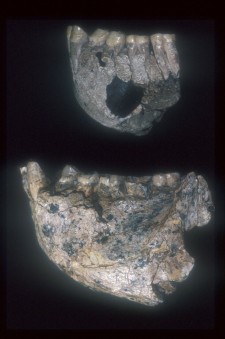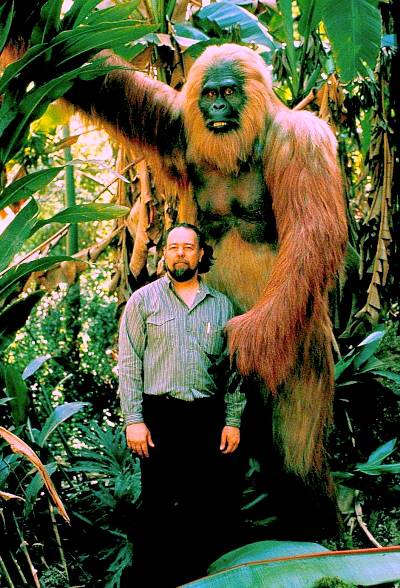As Daniel Loxton and I finished our upcoming book on cryptozoology, I needed an image of the famous huge ape fossils from Asia known as Gigantopithecus for the chapter on the Yeti. I emailed my colleague Russ Ciochon at the University of Iowa, who has found many new specimens, and got a rather surprising reply on why he would not share his images with anyone: “Gigantopithecus is not part of cryptozoology. Yet that is the only way anyone hears about Gigantopithecus.” I was rather surprised at his brusque attitude toward a scientific colleague who is on his side, but I can see where he must be fed up with non-stop requests from cryptozoologists who are only interested in his work to support their completely unscientific notions.
The original Gigantopithecus blacki specimens were found in some Chinese cave deposits, first discovered in the 1920s. They include teeth and a complete lower jaw. Unfortunately, there are no other skeletal parts known from this mysterious gigantic ape, despite decades of searching by the large number of Chinese paleontologists who now work on the deposits. More recently, Ciochon has revisited this region, and found more specimens of Gigantopithecus. He did so by shifting his focus to cave deposits in North Vietnam, which are unspoiled by the fossil poachers who robbed the Chinese caves to supply “dragon bones” for apothecaries to grind up into Chinese “medicine”. Still, even after more than 75 years since the first tooth was found, we still have only three lower jaws and about 1300 isolated teeth of this mysterious primate. There is also a second species, Gigantopithecus giganteus, from India, which (despite its name) is about half the size of Gigantopithecus blacki. A third species, Gigantopithecus bilaspurensis, comes from much older beds (6 to 9 million years old) in India, suggesting that the Gigantopithecus line goes back to at least 9 million years ago and the evolutionary radiation of early apes such as the dryopithecines (Ciochon, 1991).
Because we have only the lower jaws to go on, it’s hard to reliably estimate the size of the entire creature. Ciochon et al. (1990a) estimated that it was about 10 feet (3 m) tall and weighed about 1200 pounds. Simons and Ettel (1970) suggest it was proportioned like more like a gorilla, standing about 9 feet tall and weighing about 900 pounds. Either way, it was the largest primate that ever lived, immensely larger than a gorilla (the largest living primate), or even the biggest human giants.

Comparison of an old male jaw (bottom) and a female jaw, showing the extreme robustness and the large thick-enameled molars
What we do have of Gigantopithecus are the heavily built jaws with huge teeth, especially the molars, which have very thick enamel. Both the molars and the cheek teeth in front of them (the premolars) are very broad and low-crowned, often with their entire occlusal surface ground down flat, suggesting that these creatures ate a very tough, gritty diet. Ciochon et al. (1990b) used microscopic analysis of wear facets on the tooth enamel, and the presence of phytolith fossils from plants, showed that the Chinese apes ate mostly bamboo, as does the living giant panda.
Gigantopithecus had lived in Asia since at least the middle Miocene, about 9 million years ago, and were found mostly in eastern Asia during the Ice Ages. Careful dating of cave deposits in Vietnam which yield both Gigantopithecus and Homo erectus showed that early humans invaded China about 800,000 years ago, and that Gigantopithecus died out about half a million years later, around 300,000 years ago (Ciochon et al., 1996). Although this certainly disproves the idea that Homo erectus immediately killed off its distant cousin, there are also other possible factors, including competition with giant pandas which competed for bamboo, and also the fact that bamboo suffers from huge die-offs every 20-60 years, which may have stressed the ape population and made them more vulnerable to competition from pandas or people.
Or did they die out? As Brian Regal points out (Regal, 2011), back in the 1950s and 1960s some anthropologists like Carleton Coon made the inference that the Yeti was a relict population of Gigantopithecus. At that time, many anthropologists embraced the “multi-regional hypothesis,” which argued that Homo sapiens had evolved separately over a million years ago from different stocks of primates in different regions. Asians were descendants of Peking Man, Neanderthals descendants of some early European Homo fossils, Africans were descendants of African Homo erectus, and so on. Although there are still a few holdouts who still support a version of the multiregional model (like Milford Wolpoff at University of Michigan), genetic evidence that amassed since the 1980s has overwhelmingly demonstrated that it is false. Instead, the human genome shows that modern Homo sapiens are all descended from African ancestors that spread across the Old World about 60,000 years ago, displacing any older populations of Homo (such as “Peking man” or “Java man”) that might still have been living there. And the fossils plus the dating showed that this “out of Africa” model occurred more than once, since Homo erectus appears to have originated in Africa and then spread around the Old World (China, Java, and many other places) about 1.85 million years ago. However, even more recent work in genetics (Wells, 2002) shows that some populations (like Neanderthals) interbred with Homo sapiens, so when the invaders from Africa arrived, they did interbreed with the locals and incorporated the regional genome into theirs. Nonetheless, the archaic idea of multi-regionalism and independent, isolated parallel evolution of humans from local Homo erectus populations as advocated by Coon in the 1950s (with its racist overtones) has long been discredited by anthropologists. So Gigantopithecus is no longer viewed as connected to the Yeti, or in any way relevant to this debate.
Not surprisingly, cryptozoologists like Heuvelmans in 1952 and later many others also made suggestions that the Yeti (and later, Bigfoot) were surviving descendants of Gigantopithecus. If you read the cryptozoological literature, it is full of bizarre unsupported speculations about how these immense apes spread all over Asia and North America from different primate stocks, and Bigfoot and Yeti are their relicts. None of this amateur speculation bears any relation to what anthropologists know about the real history of hominid fossils and human evolution. This demonstrates once again that amateurs are out of their depth and use outdated concepts of human evolution when they propose their wild ideas. Nevertheless, there are many strong lines of argument against the idea that either the Yeti or Bigfoot is a surviving Gigantopithecus:
For one thing, Gigantopithecus was a giant relative of the orangutan, not a close relative of humans. Although we don’t have much evidence of its skeleton, it is reasonable to assume that its feet would be arranged like that of an orangutan or other great ape, not like that of a human with its reduced big toe and inability to grasp with its foot. Thus, its footprints should resemble ape footprints, not the human-like footprints allegedly produced by the Yeti or Bigfoot. And it should show the same stooped knuckle-walking gait of the orangutan, gorilla, and all other great apes, not the human-like bipedal walking posture allegedly shown by the Yeti and Bigfoot. (Indeed, one of the biggest problems with the Patterson-Gimlin Bigfoot film is that the walking posture is almost completely human, not ape-like in the least). Any time you read about cryptozoologists trying to connect Gigantopithecusto Yeti or Bigfoot, it shows they know almost nothing about fossil and living primates.
Second, although Gigantopithecus fossils are rare, something that large would still be expected to be fossilized at least a few times if they had survived anywhere in the world after 300,000 years ago. For example, one Bigfoot website claims that ”No research group has ever made an attempt to look for Giganto bones in North America, so no one should be surprised that Giganto remains have never been identified in North America. Ironically, the most vocal skeptics and scientists who rhetorically ask why no bones have been located and identified on this continent are the last people who would ever make an effort to look for them.” This claim is patently false, and shows how completely ignorant this writer is about paleontology and the fossil record. Paleontologists do not go out specifically to look for a particular fossil, but they collect any and all deposits that yield decent fossils. For deposits of the last 300,000 years (middle and late Pleistocene), we have an extraordinarily good fossil record in both China (where hundreds of Chinese paleontologists have been working for many decades) and especially North America, where we have excellent fossil records (especially of larger mammals, and especially from cave deposits) in every state in the United States and most Canadian provinces (Kurten and Anderson, 1980). Hundreds of paleontologists have collected these fossils for over a century and documented them in excruciating detail. Many extremely rare species are known, including an American cheetah and a camel that is built like a mountain goat, among others. Yet not once has anything resembling Gigantopithecus ever been found—not even the smallest tooth fragment (which could be easily recognized by its thick enamel and distinct low-crowned cusps). Contrary to the conspiratorial thinking of cryptozoologists, paleontologists would be overjoyed to find such a fossil and announce it with great fanfare if they had one, because such a discovery could make your reputation. They have no reason to hide such a fossil in hopes that it won’t give comfort to cryptozoologists. In fact, most paleontologists don’t even know or care about cryptozoology at all, so they are not worried about whether cryptozoologists might be affected. Instead, this statement shows that cryptozoologists such as this writer have no clue about fossils, and are using their ignorance to support their fantasies about fossils.
Finally, the best reason of all to dismiss the idea that Gigantopithecus survives today: all the evidence (and lack of evidence) that shows that neither the Yeti or Bigfoot is likely to exist, but the product of bad observations and bad science and lots of wishful thinking. Our upcoming book will discuss this evidence in detail.
References
- Ciochon, R. 1991. The ape that was. Natural History November: 54-62.
- Ciochon, Russel L., John Olsen, and Jamie James, 1990a. Other Origins: The Search for the Giant Ape in Human Prehistory. New York: Bantam Books.
- Ciochon, Russell L., Dolores R. Piperno, and Robert G. Thompson, 1990b. Opal phytoliths found on the teeth of the extinct ape Gigantopithecus blacki: Implications for paleodietary studies. Proceedings of the National Academy of Science, 87: 8120-8124.
- Ciochon, R.; et al. 1996.”Dated Co-Occurrence of Homo erectus and Gigantopithecus from Tham Khuyen Cave, Vietnam” . Proceedings of the National Academy of Sciences of the United States of America 93 (7): 3016–3020.
- Kurtén, B., and E. Anderson, 1980. Pleistocene Mammals of North America. Columbia University Press, New York.
- Regal, B. 2011. Searching for Sasquatch: Crackpots, Eggheads, and Cryptozoology. Palgrave Macmillan, New York.
- Simons, Elwyn L., and Peter C. Ettel 1970. Gigantopithecus. Scientific American, January, 1970: 77-85.
- Wells, S. 2002. The Journey of Man: A Genetic Odyssey. Princeton University Press, Princeton.


No comments:
Post a Comment